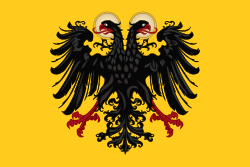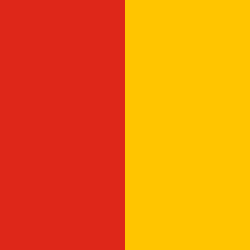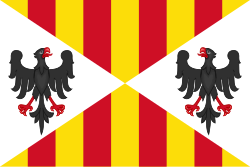1444
| 2. tisíciletí |
◄◄ ◄ 1440 • 1441 • 1442 • 1443 • 1444 • 1445 • 1446 • 1447 • 1448 ► ►►
1444 (MCDXLIV) byl rok, který dle juliánského kalendáře započal středou.
Události
10. listopad – proběhla bitva u Varny, která ukončila křížové tažení proti Osmanům, jež bylo reakcí na uzavření církevní unie ve Florencii. V bitvě padl nebo se ztratil polský a uherský král Vladislav III. Varnenčik.
Probíhající události
- 1431–1445 – Basilejsko-ferrarsko-florentský koncil
- 1436–1449 – Lučchuan-pchingmienské války
Narození
- 24. ledna – Galeazzo Maria Sforza, milánský vévoda († 1476)
- ? – Donato Bramante, italský architekt a malíř († 1514)
- ? – Elio Antonio de Nebrija, španělský jazykovědec († 2. červenec 1522)
- ? – Gaston z Foix, kníže z Viany, následník navarrského trůnu († 23. listopadu 1470)
Úmrtí
- 26. dubna – Robert Campin, nizozemský malíř (* kolem 1375)
- 20. května – Bernardin Sienský, italský kněz, františkán a světec (* 1380)
- 27. srpna – Hynce Ptáček z Pirkštejna, český šlechtic (* kolem 1400)
- 10. listopadu
- Giuliano Cesarini, italský duchovní, kardinál a papežský diplomat, který přivedl do Čech čtvrtou křížovou výpravu proti husitům (* 1398)
- Vladislav III. Varnenčik, polský a uherský král (* 31. října 1424)
- Jang Š'-čchi, politik mingské Číny (* 1364)
Hlavy států
Evropa
Území dnešní ČR a Střední Evropa
 České království – interregnum
České království – interregnum Moravské markrabství – interregnum
Moravské markrabství – interregnum Polské království – Vladislav III. Varnenčik, po jeho smrti Ladislav Pohrobek
Polské království – Vladislav III. Varnenčik, po jeho smrti Ladislav Pohrobek Litevské velkoknížectví – Kazimír IV. Jagellonský
Litevské velkoknížectví – Kazimír IV. Jagellonský Uherské království – Vladislav III. Varnenčik
Uherské království – Vladislav III. Varnenčik
Německo
 Svatá říše římská – Fridrich III. Habsburský
Svatá říše římská – Fridrich III. Habsburský Bavorské vévodství – Ludvík VIII. Mladší (Ingolstadt), Jindřich XVI. Bohatý (Landshut), Albrecht III. (Mnichov)
Bavorské vévodství – Ludvík VIII. Mladší (Ingolstadt), Jindřich XVI. Bohatý (Landshut), Albrecht III. (Mnichov) Württemberské hrabství – Ulrich V. (Stuttgart), Ludvík I. (Urach)
Württemberské hrabství – Ulrich V. (Stuttgart), Ludvík I. (Urach)
Itálie
 Papežský stát – papež Evžen IV., Amadeus VIII. Savojský (vzdoropapež)
Papežský stát – papež Evžen IV., Amadeus VIII. Savojský (vzdoropapež) Sicilské království – Alfons V. Aragonský
Sicilské království – Alfons V. Aragonský Sardinské království – Alfons V. Aragonský
Sardinské království – Alfons V. Aragonský Benátská republika – Francesco Foscari
Benátská republika – Francesco Foscari Neapolské království – René I. Dobrý
Neapolské království – René I. Dobrý Milánské vévodství – Filippo Maria Visconti
Milánské vévodství – Filippo Maria Visconti Florentské vévodství – Cosimo I. Medicejský
Florentské vévodství – Cosimo I. Medicejský
Balkán
 Srbský despotát – Đurađ Branković
Srbský despotát – Đurađ Branković Knížectví Zeta – Đurađ Branković
Knížectví Zeta – Đurađ Branković Chorvatské království – Vladislav III. Varnenčik
Chorvatské království – Vladislav III. Varnenčik Bosenské království – Tomáš Bosenský
Bosenské království – Tomáš Bosenský
Ostatní
 Anglické království – Jindřich IV. Anglický
Anglické království – Jindřich IV. Anglický Kalmarská unie – Kryštof III. Bavorský
Kalmarská unie – Kryštof III. Bavorský Francouzské království – Karel VII. Francouzský
Francouzské království – Karel VII. Francouzský Kastilská koruna – Jan II. Kastilský
Kastilská koruna – Jan II. Kastilský Monacké knížectví – Jan I. Monacký
Monacké knížectví – Jan I. Monacký Granadský emirát – Muhammad IX. Granadský
Granadský emirát – Muhammad IX. Granadský
Blízký Východ a Severní Afrika
 Byzantská říše – Jan VIII. Palaiologos
Byzantská říše – Jan VIII. Palaiologos Osmanská říše – Murad II., po abdikaci jeho syn Mehmed II.
Osmanská říše – Murad II., po abdikaci jeho syn Mehmed II.- Akkojunluská říše – Hamza bin Osman, po jeho smrti Džahangir bin Ali
Dálný Východ a Asie
 Dillíský sultanát – Muhammad Šáh IV.
Dillíský sultanát – Muhammad Šáh IV. Čínské císařství – Ču Čchi-čen
Čínské císařství – Ču Čchi-čen Japonské císařství – Go-Hanazono
Japonské císařství – Go-Hanazono
Amerika
Externí odkazy
 Obrázky, zvuky či videa k tématu 1444 na Wikimedia Commons
Obrázky, zvuky či videa k tématu 1444 na Wikimedia Commons
Média použitá na této stránce
Autor: Samhanin & Havsjö (change the color of the 'Royal banner of the Kingdom of Bohemia.svg'), Licence: CC BY-SA 4.0
Royal banner of the Kingdom of Bohemia (1305)
Autor: Samhanin, Licence: CC BY-SA 3.0
Banner of the Margraviate of Moravia
Banner of Kingdom of Poland in the 14th century
A seal of Duke Premislaus II from 1290 shows the ruler holding a banner emblazoned with a crowned eagle. During the reign of King Ladislaus (r. 1320–1333), the red cloth with the White Eagle was established as the royal banner. The orientation of the eagle on the banner varied; its head could point either upwards or towards the hoist.
Autor: Samhanin, Licence: CC0
Royal military banner of the Grand Duchy of Lithuania with the Double Cross of the Jagiellonian dynasty on the shield of horse rider.
Autor: David Liuzzo, eagle by N3MO, Licence: CC BY-SA 3.0
Banner of the Holy Roman Empire, double headed eagle with halos (1400-1806)
Rautenflagge (24 Rauten)
Flag of the Kingdom of Württemberg; Ratio (3:5)
Flag of the Papal States before 1808.
Při zobrazení tohoto souboru lze snadno přidat orámování
State Flag and War Ensign of the Kingdom of Sardinia (1816-1848).
Autor: Tento vektorový obrázek byl vytvořen programem Inkscape ., Licence: CC BY-SA 4.0
Official flag of the Republic of Venice used by the Doge Domenico Contarini.
Při zobrazení tohoto souboru lze snadno přidat orámování
Při zobrazení tohoto souboru lze snadno přidat orámování
Autor: Old!!man1234561234, Licence: CC BY-SA 3.0
Flag of the Serbian Despotate, 1402-1459.
According to several sources this is Stag of the House of Crnojević, originally Nemanjić; used by the autonomous Ottoman Sanjak of Montenegro in the early 16th century, hangs on top of the Cetinje Monastery.
Autor: Samhanin, Licence: CC BY 3.0
Flag of Croatia (Early 16th century–1526) per source, which is historically innacurate as such a flag or coat of arms was used only since 1527 when the Croatian nobility elected the Habsburg dynasty.
Autor: Santasa99, Licence: CC BY-SA 4.0
Bosnian Royal Flag of Tvrtko I of Bosnia
This is merely a recreation of what the flag is thought to have looked like. There are no surviving flags or pictorial evidence as to its appearance. See article at Flags of the World.
Autor: Oren neu dag (talk), Licence: CC BY-SA 3.0
Royal flag of France before the Revolution (heraldic banner of "France modern")
Autor: Heralder, Licence: CC BY-SA 3.0
Royal Standard of the Crown of Castile (15th Century Style)
SVG version of en:Image:Monaco_flag_with_lozenges.png (now deleted as superseded). The diamond pattern came from User:Denelson83.
Autor: SanchoPanzaXXI, Licence: CC BY-SA 4.0
Estandarte de los reyes nazaríes de Granada. El color rojo era distintivo de la dinastía real nazarí [1]. Lleva el lema propio a esta dinastía «Wa lā gāliba illā-llāh» (Solo Alá es vencedor) وَ لاَ غـَالِـبٌ إلاَ اللـَّه. Otra variante se muestra en el Atlas Mediterráneo de Cresques (s. XIV) [2] con el lema al-afiyya (salud, bienestar…) de oro sobre fondo rojo.
Autor: Cplakidas, Licence: CC BY-SA 3.0
The Byzantine imperial ensign (βασιλικόν φλάμουλον), as depicted in the 14th-century Castilian Book of All Kingdoms, and described in the Treatise on Offices by the mid 14th-century Byzantine writer Pseudo-Kodinos as being hoisted on imperial naval vessels. It features the tetragrammic cross with the four "B"s that is attested in contemporary portolans, on coins and reliefs.
The Ottoman flag and Turkey Republic Flag of 1844–1935. Late Ottoman flag which was made based on the historical documents listed in the Source section. Note that a five-pointed star was rarely used in the crescent-and-star symbol before the 19th century.
Flag of the Sultanate of Delhi according to the Catalan Atlas (1375). The flag is grey with a black band in the Catalan Atlas (attached image), not green with a black band as previously uploaded.
The actual grey and black color appears clearly in the primary source (and the Catalan Atlas has plenty of green otherwise, so the grey cannot be a result of color fading), and this interpretation is confirmed by academic sources:
REFERENCE: "....that helps to identify yet another curious flag found in northern India – a brown or originally sliver flag with a vertical black line – as the flag of the Delhi Sultanate (602-962/1206-1555)." in (2010). "On the Timurid flag". Beiträge zur islamischen Kunst und Archäologie 2: 148.
WARNING: This is primary source image, the actual flag is otherwise unknown. The main source pointing to this design is the Catalan Atlas, which as a historical primary source. This image should not be added to articles without clearly attributing its primary source origin, and secondary sources are additionally desired if available (such as the one above). Note that FOTW (where most of those flags on Commons are adapted from) is based on user contributions like Wikipedia, and hence not authoritative.
OVERWRITING OF FICTIONAL FLAG:
“Seal of the Emperor of the Great Ming [Dynasty]”。
Autor: Adapted from Huhsunqu, made by Pachakutec, Licence: CC BY-SA 2.5
Suntur Paucar, according to the description of the chronicles of Bernabé Cobo
Banner of Kingdom of Poland in the 14th century
A seal of Duke Premislaus II from 1290 shows the ruler holding a banner emblazoned with a crowned eagle. During the reign of King Ladislaus (r. 1320–1333), the red cloth with the White Eagle was established as the royal banner. The orientation of the eagle on the banner varied; its head could point either upwards or towards the hoist.






























